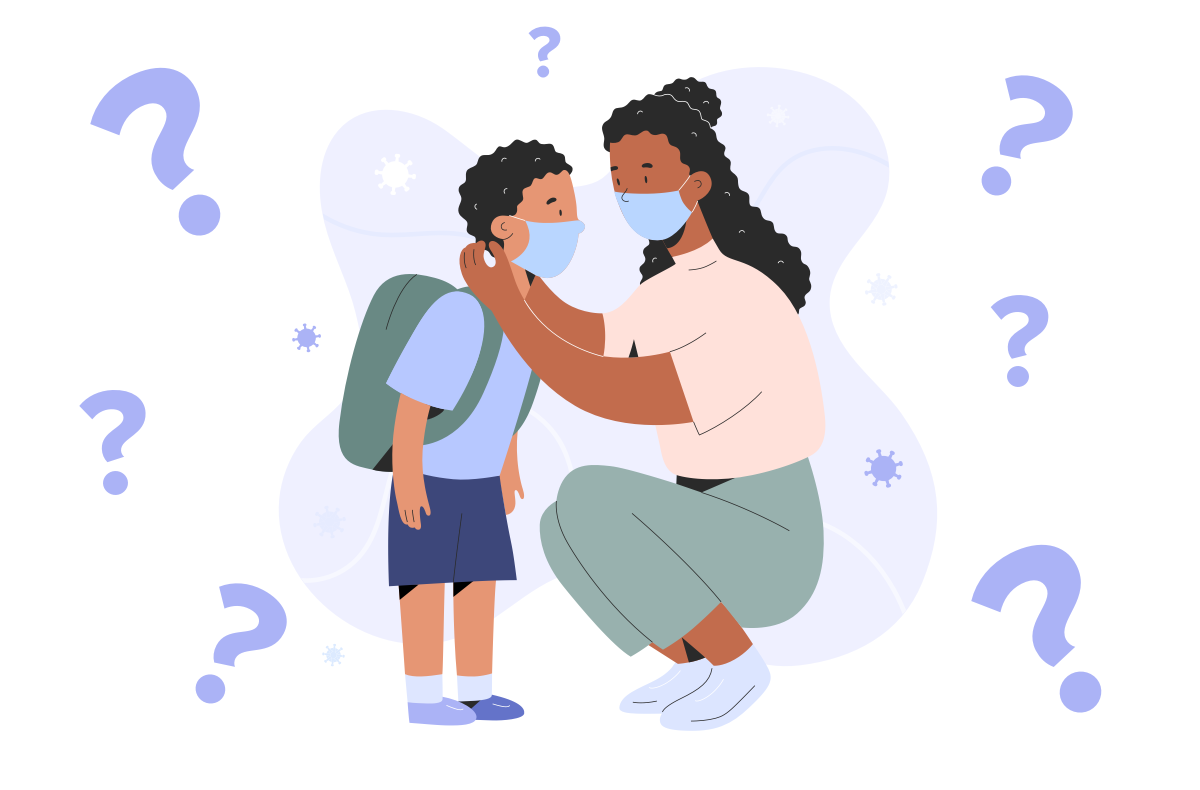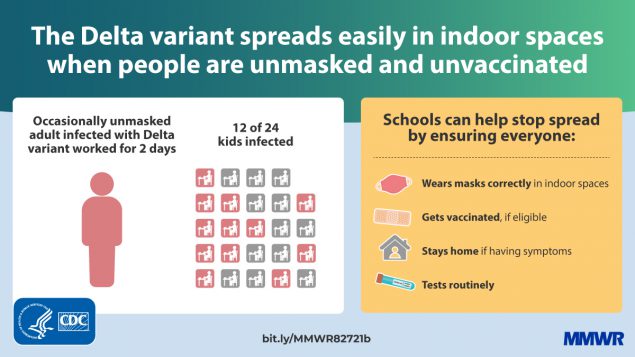Back To School During The Delta Variant
9:16 minutes

This story is a part of Science Friday’s coverage on the novel coronavirus, the agent of the disease COVID-19. Listen to experts discuss the spread, outbreak response, and treatment.
Back-to-school is usually an exciting time, with some nerves mixed in. But this year is a little different. All across the country, arguments about mask mandates are exploding in school board meetings and courtrooms. In places with no mask mandates, parents are weighing difficult decisions over how much risk is too much.
But masks are just part of the equation for school safety. Air ventilation and distance are both important parts of the COVID-19 transmission equation, and many parents have questions about how their schools are preparing.

With pediatric COVID-19 cases rising, and Delta’s high transmission rates, many are wondering how we’re going to keep our kids safe in schools. Joining Ira to mull over this question is Dr. Katelyn Jetelina, assistant professor at the University of Texas School of Public Health in Dallas, Texas.
Despite the educational challenges ahead, many science educators are eager to eager to return to in-person instruction this fall. We checked in with some educators from around the country to get a preview of what they are excited to explore with their students this year.
If you’d like to respond to our questions (and potentially have your voice on the air), download our SciFri Voxpop app.
Invest in quality science journalism by making a donation to Science Friday.
Katelyn Jetelina is an adjunct professor in the UTHealth School of Public Health, and author of the Your Local Epidemiologist newsletter.
IRA FLATOW: Concerns about kids going back to school are not limited to Florida. All over the country, arguments about mask mandates are exploding in school board meetings and courtrooms. In places with no mask mandates, parents are making decisions about if they should send their kids to school with masks anyway.
And masks are just part of this equation. You may be wondering what your school is doing about air ventilation or rules about keeping kids six feet apart. With rising pediatric COVID cases, we are all wondering, how do we keep our kids safe?
So joining me today to talk about the science behind back to school in the time of delta variant is Dr. Katelyn Jetelina, Assistant Professor at the University of Texas School of Public Health based in Dallas. Welcome to Science Friday.
KATELYN K. JETELINA: Hi. Thanks for having me. I’m excited to be here.
IRA FLATOW: Nice to have you. Obviously, Texas is a huge state. And you can’t cover the whole thing. But what are you hearing about how back to school is going?
KATELYN K. JETELINA: So we’ve been back to school for about two weeks now in Texas. And things aren’t going very well. We have really high community transmission rates. And kids in schools are part of the community. And so we’re going to see high rates among kids in schools.
And we are having tens to hundreds of cases of COVID among kids in schools right now, with thousands in quarantine. Unfortunately, this has actually even closed some schools and some schools to change their mind and start mandating masks as well.
IRA FLATOW: It feels like this year there’s way more debate about mask mandates and safety than last year. Is this true? I mean, is that my perception? Is it correct? Why is that?
KATELYN K. JETELINA: It is a correct perception. It’s a very strong and exhausting debate this year. And I think it has to do with a couple of things.
One, this school is very different than last school year. Last school year, we had the option of virtual learning. Not everyone was going into schools. If they were going into schools, they were wearing masks and staying vigilant and socially distanced.
Now, it’s a different ballgame. There is pandemic fatigue. There is also this perceived knowledge that kids aren’t at high risk for COVID. And schools aren’t even implementing public health mitigation measures that we know work and are especially important with this new variant of delta.
IRA FLATOW: We got a question on our SciFri VoxPop app from an elementary school teacher in Indiana. I’m going to play it for you now.
[AUDIO PLAYBACK]
– In Indiana, we start school in late July. And so we are in our fifth week currently. I guess my question is, why is COVID hitting us so much harder this year? Since the start of school this year in this five weeks, we have already tripled our number of positive cases from all of last year combined.
And it is exhausting. I can’t figure out what it is exactly. Is it delta being more contagious? Is it delta not sparing kids the way the previous versions had? All of those things combined? And what can we do?
[END PLAYBACK]
IRA FLATOW: Wow, yeah. That’s exactly what you said you were seeing in Texas. Do you have an answer for this listener?
KATELYN K. JETELINA: Yeah. So like I said, delta has changed the game. And it’s changed the game in a number of factors.
One, it’s more transmissible. It’s more contagious than previous variants. So one infected kid or one infected teacher on average will infect about eight others compared to before whereas one infected with infect about two other people.
The other game changer is that people that are infected have thousand times the viral load. And so what this means is people test positive more quickly following exposure. And they shed a ton more virus for longer. So if you come in contact with a positive case, the probability of getting infected increases and you have the opportunity to infect others too for longer.
Two other things that changes the game– one, vaccinated can now transmit the virus. This wasn’t the case before delta. Before delta, vaccines reduced transmission by about 90%. And unfortunately, with delta, vaccinated has about the same viral load. So it looks like vaccinated reduces transmission by a little, but certainly not by a lot like we saw before.
And then finally, what that listener pointed to was that, yes, delta is a more severe disease. And we know this among adults very well. So in the UK, we saw that delta patients had two times the risk of hospital admission. A study in Singapore showed that delta patients have higher risk of needing oxygen going to the ICU and even dying.
The big question right now though that we don’t have the answer to is, is delta more severe for kids? We think that, since it is for adults, it will be for kids. But we haven’t seen the evidence yet.
IRA FLATOW: This is Science Friday from WNYC Studios. You know, that’s all really interesting stuff because I want to talk about the CDC case that was published recently. Last May in Marin County, California, a teacher who was symptomatic and unvaccinated infected half the classroom.
And the kids were all under 12, so too young to be vaccinated. And they, the kids, were all masked. But the teacher’s mask came off occasionally for reading time.
And then you had parents and siblings and co-workers all getting sick from this event. And this classroom had HEPA filters. It had windows wide open. It seems like they were doing everything right except for the sick teacher taking off the mask. What do you take from this case?
KATELYN K. JETELINA: Yeah, it’s unfortunately going to be the reality when we start opening up these schools. And this is a fantastic example that was published. The biggest thing that we can prevent for this not happening is getting teachers vaccinated. We need teachers– we need staff vaccinated.
And then if you are sick, do not come to school. Stay at home. Quarantine. Get tested.
And then also, yes, wear a mask. That teacher should have been wearing a mask the entire time and not taking off while reading that story aloud to the students. Unfortunately, like you mentioned, all of these students were under the age of 12. So they were unvaccinated.
They were masked, which is very refreshing to hear. The problem is that masks need to be worn correctly. They need to have a really great fit. They need to have a good filter. And they need to be comfortable for kids.
And so with delta, we really need to step up our mask game. We can’t have kids wearing cloth masks. We should be getting them really effective masks like the KN94 or KN95 to particularly help with this very transmissible, very contagious variant.
IRA FLATOW: So let me ask you as an epidemiologist. If you were to come up with a way to safely go back to school, how would you do it?
KATELYN K. JETELINA: Yeah, I think I kind of– I just explained my ideal world. 100% vaccination rate among those that are eligible. Among those that are 12 and plus, everyone needs a vaccine. Ideally, we could have classrooms outside. I know that’s not ideal where I am in Texas where we get to 100 degrees. And it certainly won’t be ideal once we start hitting the winter months in the Northeast.
But having as much airflow– because we know this delta is more aerosol transmitted than droplets. And so air flow is really important too. And then like I said, really good masks– those that fit, those that are effective from a filter perspective, and those that are comfortable so kids do adhere to masking all day long in the classroom.
IRA FLATOW: Very good points. Thank you for making them for us. That’s about all the time we have. Dr. Katelyn Jetelina, Assistant Professor at the University of Texas School of Public Health based in Dallas, thank you for joining us today.
KATELYN K. JETELINA: Yeah, thanks for having me.
IRA FLATOW: You’re quite welcome.
Copyright © 2021 Science Friday Initiative. All rights reserved. Science Friday transcripts are produced on a tight deadline by 3Play Media. Fidelity to the original aired/published audio or video file might vary, and text might be updated or amended in the future. For the authoritative record of Science Friday’s programming, please visit the original aired/published recording. For terms of use and more information, visit our policies pages at http://www.sciencefriday.com/about/policies/
Kathleen Davis is a producer at Science Friday, which means she spends the week brainstorming, researching, and writing, typically in that order. She’s a big fan of stories related to strange animal facts and dystopian technology.
John Dankosky works with the radio team to create our weekly show, and is helping to build our State of Science Reporting Network. He’s also been a long-time guest host on Science Friday. He and his wife have three cats, thousands of bees, and a yoga studio in the sleepy Northwest hills of Connecticut.